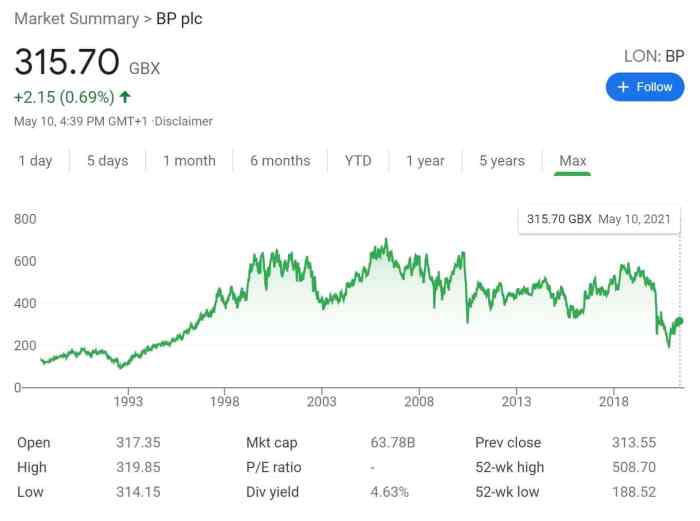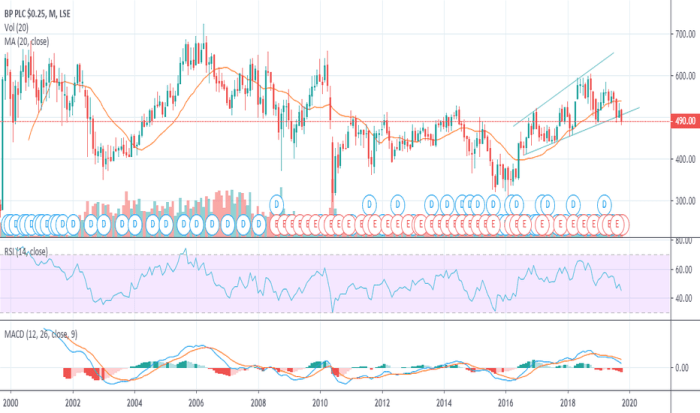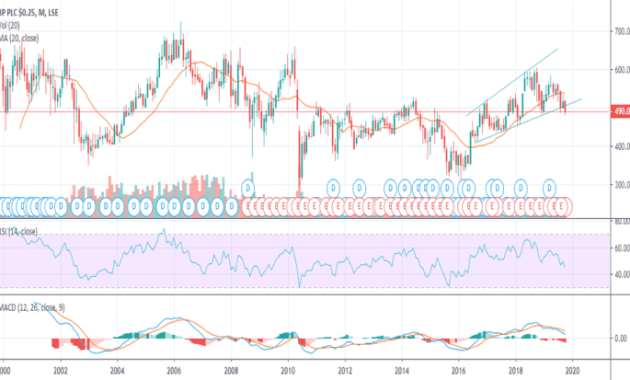BP plc Share Price: A Comprehensive Analysis: Bp Plc Share Price London Stock Exchange
Bp plc share price london stock exchange – This analysis delves into the historical performance, influencing factors, valuation methods, future predictions, and investor sentiment surrounding BP plc’s share price on the London Stock Exchange. We will examine key macroeconomic factors, company-specific events, and the impact of the global energy transition on the company’s future prospects.
BP plc Share Price History, Bp plc share price london stock exchange

Source: incomeinvestors.com
Monitoring the BP plc share price on the London Stock Exchange requires a keen eye on global energy markets. It’s interesting to compare its performance to companies in other sectors, such as the biotech industry; for example, you can check the current boundless bio stock price for a different perspective on market trends. Ultimately, understanding the BP plc share price hinges on a broader understanding of the overall economic climate and its impact on energy demand.
A comprehensive analysis of BP plc’s share price on the London Stock Exchange over the past five years reveals significant fluctuations influenced by various internal and external factors. The following sections detail these movements, comparing BP’s performance to the FTSE 100 index.
A line graph illustrating BP plc’s share price over the past five years would show periods of both growth and decline. Key dates marking significant price movements, such as those following major announcements or global events, would be highlighted. For instance, a sharp drop might be observed around the time of a major oil spill or geopolitical instability, while a rise could follow positive news regarding new energy projects or increased oil prices.
The highest and lowest share prices during this period, along with their respective dates, would be clearly indicated. For example, the highest price might have been reached during a period of high oil demand and prices, while the lowest might correlate with periods of low oil prices or negative company-specific news.
A comparative table illustrating BP plc’s share price performance against the FTSE 100 index would show the relative performance of BP’s stock compared to the broader UK market. The table would include columns for date, BP plc price, FTSE 100 price, and percentage change for both. This allows for a clear visualization of whether BP outperformed or underperformed the overall market during specific periods.
Factors Influencing BP plc Share Price
Several macroeconomic factors, oil price fluctuations, and company-specific events significantly influence BP plc’s share price. The following sections detail these influences.
Three key macroeconomic factors impacting BP plc’s share price are global economic growth, interest rates, and government regulations. Strong global economic growth typically leads to increased energy demand and higher oil prices, benefiting BP. Conversely, rising interest rates can increase borrowing costs, impacting profitability and potentially lowering the share price. Stringent environmental regulations can also affect investment decisions and operational costs, influencing the share price.
Oil price fluctuations have a direct and substantial impact on BP plc’s share price. For example, a sharp increase in oil prices, such as those seen in 2022, would typically lead to a rise in BP’s share price due to increased profitability. Conversely, a significant drop in oil prices, as seen during periods of low global demand, would negatively affect the share price.
Company-specific events, such as new project announcements, acquisitions, and regulatory changes, also influence BP plc’s share price. The following table compares three significant events and their impact on the share price. For instance, the successful completion of a major new oil field development might boost the share price, while a large environmental fine could have the opposite effect.
| Event | Date (Approximate) | Impact on Share Price | Explanation |
|---|---|---|---|
| Major Acquisition | 20XX | Positive (e.g., +5%) | Increased market share and potential for future growth. |
| New Renewable Energy Project Announcement | 20XX | Positive (e.g., +3%) | Demonstrates commitment to energy transition and potential for future revenue streams. |
| Regulatory Fine | 20XX | Negative (e.g., -2%) | Significant financial impact and reputational damage. |
BP plc Share Price Valuation

Source: co.uk
Several methods can be employed to value BP plc shares. This section details three common approaches and compares the resulting valuations to the current market price.
Three methods for valuing BP plc shares include discounted cash flow (DCF) analysis, comparable company analysis, and asset-based valuation. The DCF analysis projects future cash flows and discounts them back to their present value. Comparable company analysis compares BP’s valuation metrics to those of similar companies in the oil and gas sector. Asset-based valuation assesses the net asset value of BP’s assets.
A table summarizing the valuations obtained using these methods, compared to the current market price, would provide a comprehensive overview of BP plc’s valuation. This would highlight any potential undervaluation or overvaluation of the stock.
Potential risks and uncertainties that could affect the future valuation of BP plc shares include fluctuating oil prices, geopolitical instability, changes in environmental regulations, and the ongoing energy transition. These factors introduce uncertainty into future cash flow projections and can significantly impact the company’s valuation.
BP plc Share Price Predictions and Analysis
Analyzing BP plc’s current financial position and future outlook requires considering key financial metrics and growth projections. This section Artikels potential future catalysts and the impact of the global energy transition.
BP plc’s current financial position can be assessed using key metrics such as revenue, profit margins, debt levels, and cash flow. Future outlook projections, often found in company reports and analyst forecasts, would provide insights into expected growth rates and profitability. These projections usually consider factors such as oil price forecasts, investment plans, and operational efficiency improvements.
Potential future catalysts that could influence BP plc’s share price include:
- Successful implementation of new energy projects.
- Significant discoveries of new oil and gas reserves.
- Changes in global energy policies.
- Geopolitical instability affecting oil supply.
- Major technological breakthroughs in renewable energy.
The global energy transition presents both opportunities and challenges for BP plc. A scenario-based approach (optimistic, neutral, pessimistic) could be used to analyze the potential impact. For example, an optimistic scenario might assume rapid growth in renewable energy, while a pessimistic scenario could consider slower adoption and continued reliance on fossil fuels.
Investor Sentiment and Trading Activity

Source: tradingview.com
Understanding investor sentiment and trading activity provides valuable insights into the market’s perception of BP plc. This section analyzes trading volume, volatility, and compares BP’s trading patterns to its competitors.
Overall investor sentiment towards BP plc shares can be gauged from recent news articles, financial reports, and analyst ratings. Positive news regarding the company’s performance or strategic initiatives would generally lead to increased investor confidence and higher demand for the shares. Negative news, on the other hand, could lead to decreased investor confidence and lower demand.
An analysis of BP plc’s trading volume and volatility over the past year, illustrated using a chart, would show periods of high and low trading activity and price fluctuations. High volume during periods of significant price changes would suggest strong investor interest and potentially higher risk. Low volume might indicate less investor interest.
Comparing BP plc’s trading patterns with those of its major competitors in the oil and gas sector allows for a relative assessment of investor interest and market perception. This comparison would highlight differences in trading volume, volatility, and overall market performance.
Key Questions Answered
What are the main competitors of BP plc?
Major competitors include Shell, ExxonMobil, Chevron, and TotalEnergies.
How often is BP plc’s share price updated?
The share price is updated continuously throughout the trading day on the London Stock Exchange.
Where can I find real-time BP plc share price data?
Real-time data is available through financial news websites and brokerage platforms.
What are the typical trading hours for BP plc shares on the LSE?
Trading hours are generally 8:00 AM to 4:30 PM GMT.

